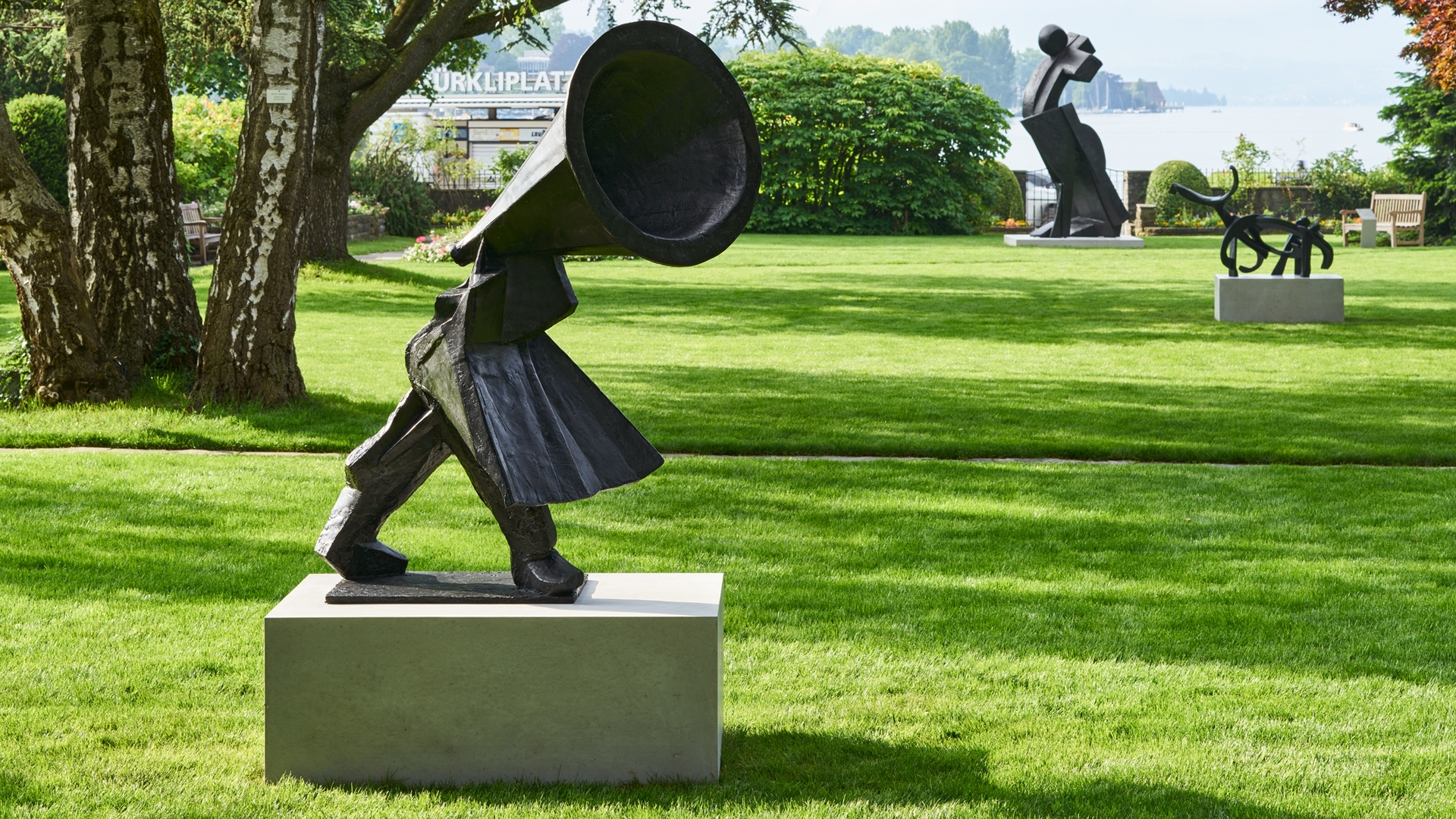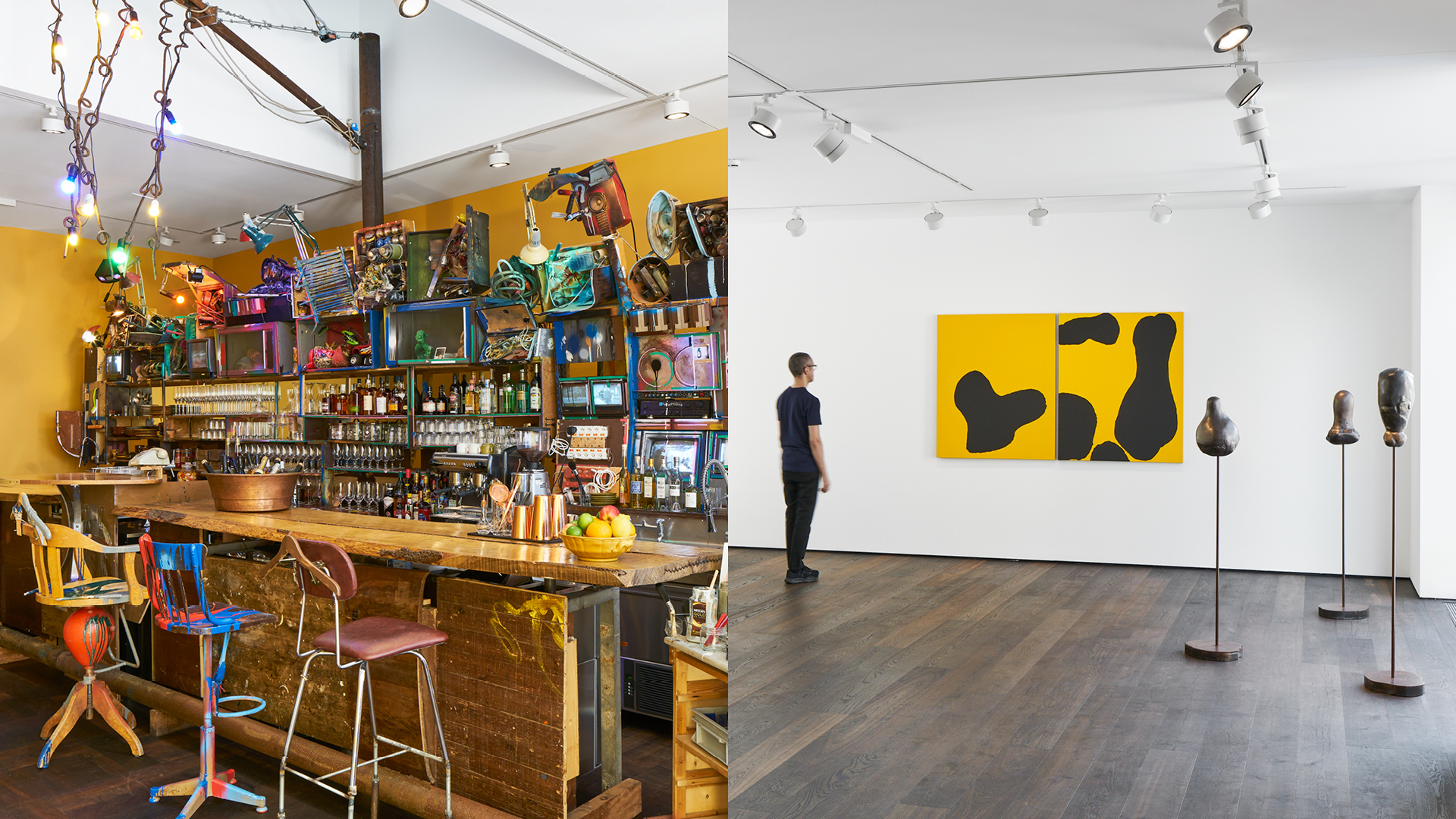
Installation view, ‘Max Bainbridge. Hollow Bodies,’ Hauser & Wirth Somerset, 2024 © Max Bainbridge. Photo: Forest + Found
Max Bainbridge Outdoor Sculpture Unveiled in Somerset
Make Hauser & Wirth’s inaugural outdoor sculpture installation ‘Hollow Bodies’ (2024) by Somerset-based artist Max Bainbridge is an examination and intervention into three sections of wind felled Scots Pine sourced from the Cairngorms in Braemar, Scotland, UK. The work speaks to the human condition and our need to protect ourselves in times of crisis; to don a metaphorical armour in the hope that our fragile and complex place within the natural world can persist and endure. Through the stripping of bark, casting of branches, burning of trunks and coatings of pine tar, Bainbridge explores what is imbibed and held within these trees throughout their lifetime. He looks to how their environment has shaped and changed them, and in doing so, reflects on our own place within the natural world, and its effects upon us.
The scale of these sculptures has an intimate monumentality, they speak to the human, yet they connect us to the expansive landscape of the Cairngorms. To experience them up close is to be placed within ‘their landscape,’ ‘their environment;’ transported or transplanted back to the Scottish Highlands and the hillsides where they once stood. There is a confrontation that takes place on encountering these ‘Hollow Bodies.’ They have been denuded, stripped of their bark, their armour, and their skin. In this act of ‘othering’ Bainbridge questions what have they now become? He shifts the narrative from growth, strength and fertility to that of vulnerability, fragility and mortality. Each tree offering a different lament on what it means to be human, to exist within a fragile and ever-changing ecosystem.

Max Bainbridge’s residency in Braemar, Scotland, UK, 2023. Photo: Forest + Found

Max Bainbridge’s residency in Braemar, Scotland, UK, 2023. Photo: Forest + Found
‘My initial thoughts were to try and preserve. Once these sections of Scots pine were out of their environment and back in the studio, this started the conversation of how we give them back their longevity, which led to the processes involved, the stripping, the coating, the casting. They became something other. The addition of pewter, I see as my attempt to protect the tree sections. Those interventions and my hand are present in the work and that is important. It is not about perfection but rather the intentional use of material.’—Max Bainbridge

Max Bainbridge, Hollow Bodies (detail), 2024 © Max Bainbridge. Photo: Forest + Found

Max Bainbridge, Hollow Bodies (detail), 2024 © Max Bainbridge. Photo: Forest + Found
The work also takes inspiration from the architectural vernacular around Braemar, Scotland, UK, whilst also referencing the practical ways in which the trees have historically been used. For example, examining trees as structural supports at the front of dwellings, looking at how people have relied upon these trees for shelter—building and creating places to live—and the way that native trees have entered the collective conscious of those that live within this landscape.
Creating a sculptural installation that speaks of the complex relationships we have with nature and our natural environment, Bainbridge’s work invites a conversation with the tree’s interior and exterior space, both physically and emotionally. The tree body becomes a physical representation of the human, the veins and sinews that run throughout our bodies runs through it, below the fragile surface of the bark, below the surface of our skin. The size of the sculptures is also significant. They seem to sit somewhere between being monumental and intimate in scale. When approaching them as a viewer, you get the sense of scale of the ‘tree,’ yet they still feel human.
‘Hollow Bodies’ is on view at Hauser & Wirth Somerset from Saturday 10 February – Sunday 7 April 2024.

Installation view, ‘Max Bainbridge. Hollow Bodies,’ Hauser & Wirth Somerset, 2024 © Max Bainbridge. Photo: Dave Watts

Installation view, ‘Max Bainbridge. Hollow Bodies,’ Hauser & Wirth Somerset, 2024 © Max Bainbridge. Photo: Dave Watts
About Max Bainbridge
Working predominantly in wood, Max Bainbridge’s sculpture practice reflects his drive to preserve a tangible and grounded presence through the physicality of the sculpted material object. By seeking out trees that have fallen where they once grew, his sculptures retain a direct and intimate connection to land and place, recognizing the tree as a living being that can occupy both our inner psyche and the physical character of its former site. His search for the true essence of the tree is thereby ever present within the form of his large-scale vessels and free-standing sculptures. For each work, Bainbridge takes the natural shape and character of the tree itself and responds to it directly, allowing the inherent agency of the wood to push back and inform sculptural decision making. Embodying the monumental presence of the tree into objects on a more intimate human scale, his works become quiet reflections on our relationship with the natural world and the importance of evaluating our place within it.
Bainbridge trained at Chelsea College of Art, London, UK, receiving a BA Fine Art in 2013. He has exhibited his work at Make Hauser & Wirth Somerset, Bruton, UK (2018 and 2024); Informality Gallery, Oxfordshire, UK (2022); Amelie Maison D’Art, Paris, France (2022); and New Art Centre, Roche Court, Wiltshire, UK (2020). In 2023, Bainbridge undertook in a residency in Braemar, Scotland, UK with Make Hauser & Wirth. In 2014, he established Forest + Found, an art collective with whom he works on public commissions, exhibitions and curatorial projects. In 2024, Bainbridge was a John Ruskin Prize Finalist.

Max Bainbridge with ‘Hollow Bodies,’ 2024 © Max Bainbridge. Photo: Forest + Found
Related Stories
1 / 3




